Tori-bot’s Real Name Discovered
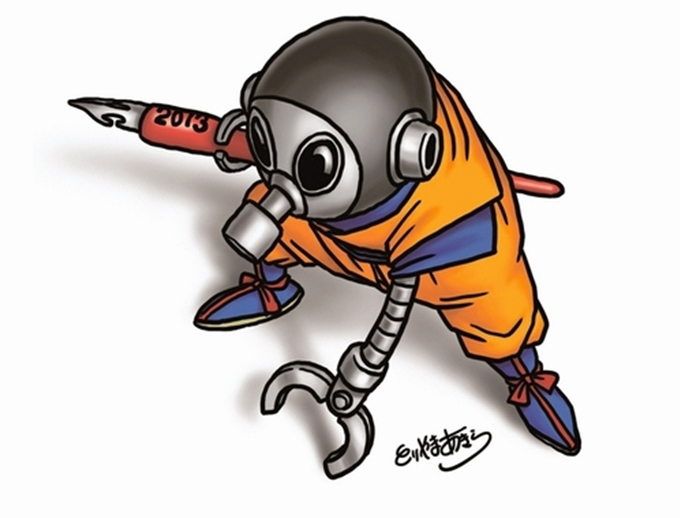
What’s this robot called? You probably think it’s the Tori-bot, but according to Akira Toriyama, you’re wrong!
Akira Toriyama is a shy man who doesn’t like showing his real face. Instead of including pictures of himself in his manga, he prefers to draw himself into the pages as an alternate persona or likeness.
Here is an image from Dr. Slump Volume 10 (May 10, 1983) that shows Toriyama’s many likenesses alongside a rare inclusion of his actual face.
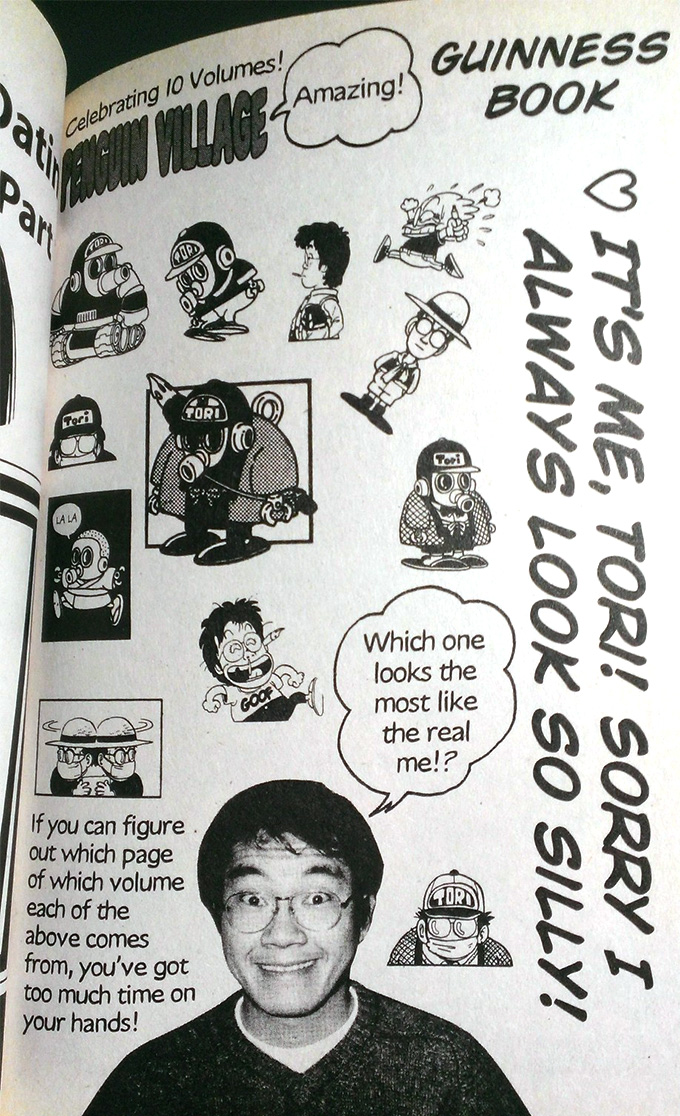
As you can see, there are several different characters that Toriyama uses to represent himself in his manga. The first (at the top right) is a bird man holding a pencil. This is the one he uses for most of his early work, and is inspired by the tori (鳥, “bird”) in his name.
The two characters next to the bird man are renderings of himself as a human being, with one wearing a farmer’s straw-hat—as an allusion to Toriyama’s real-life countryside upbringing.
From there we proceed to what most people call the Tori-bot. It’s a small robot wearing a gas mask and with a pair of claw hands.
In the center there is the first incarnation of this robot, with a wind-up key in its back, which is a carryover from most of his bird likenesses, which also have a wind-up key.
To the left of this central image is a child-like version of the Tori-bot, representing Toriyama as a young boy.
And then there’s his adult form wearing a surgical mask.
This image comes from Dr. Slump Volume 10, so let’s explore how we got to this point.
Evolution of Tori-bot
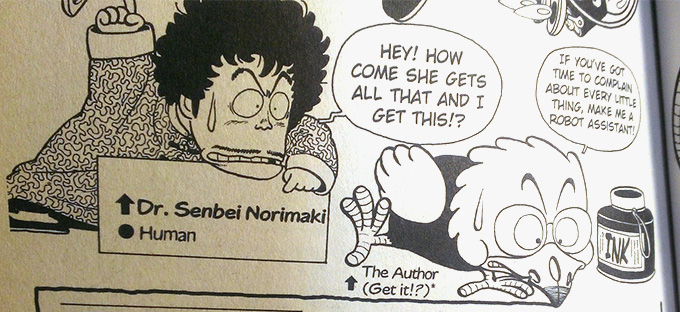
Toriyama uses his bird likeness throughout Dr. Slump Volumes 1 and 2.
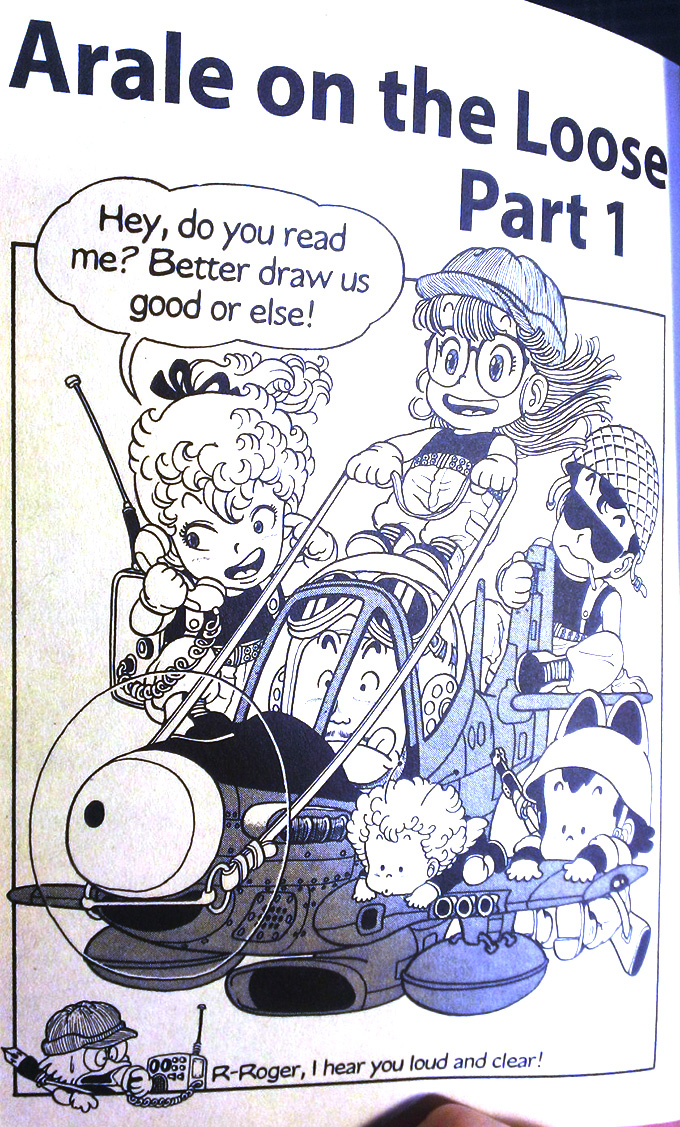
But starting in Volume 3 (December 10, 1980) he starts to draw his likeness as a robot. The first instance of the robot appearing in the manga is when he includes it as a self-portrait in the opening message portion of the book.
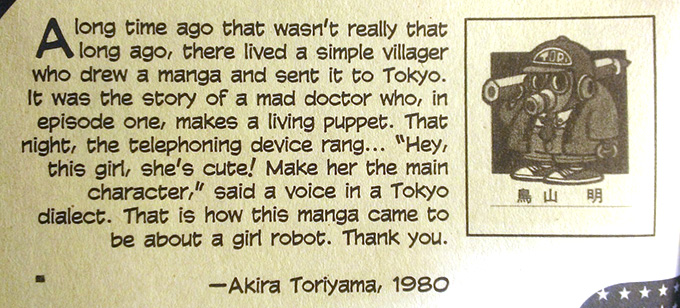
Directly after this is the table of contents.

And then throughout the book he includes several ‘history’ sections in-between chapters, where he uses the robot as a stand-in for himself in historical moments of his life.
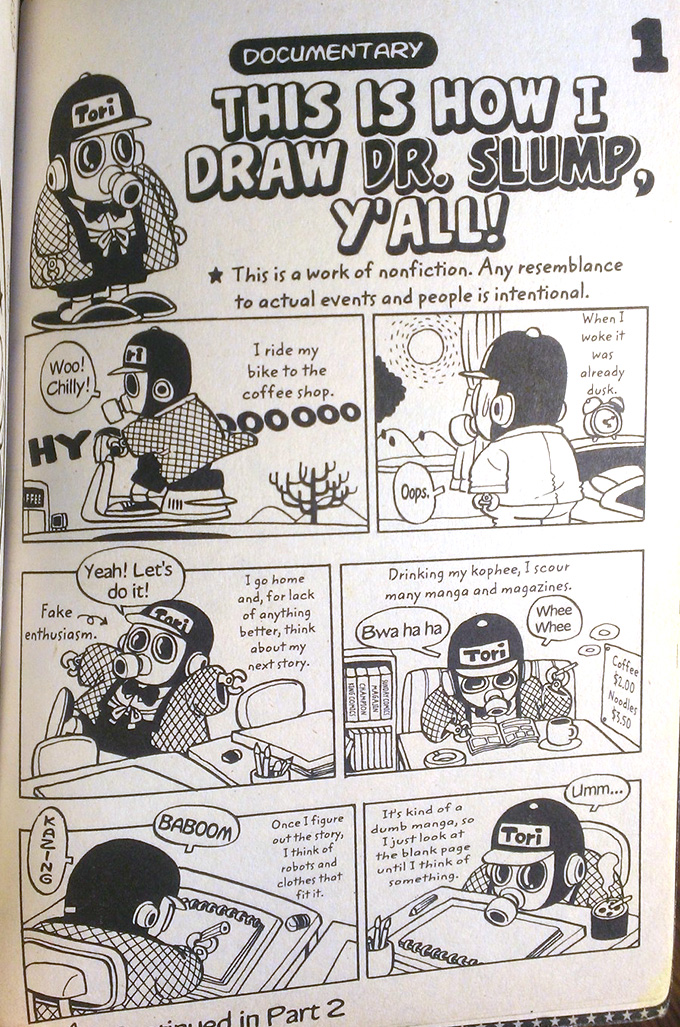
However, these are added after the serialized publication in Weekly Shōnen Jump and only exist within the volumized content.
Throughout Volume 3 he never once names the character. It’s just made clear that this robot-thing is the author because he uses the word “I” when speaking.
He then goes on to switch things up. In Volume 4 (April 10, 1981) he uses a different bird likeness, with a fatter body and cherub-like wings.
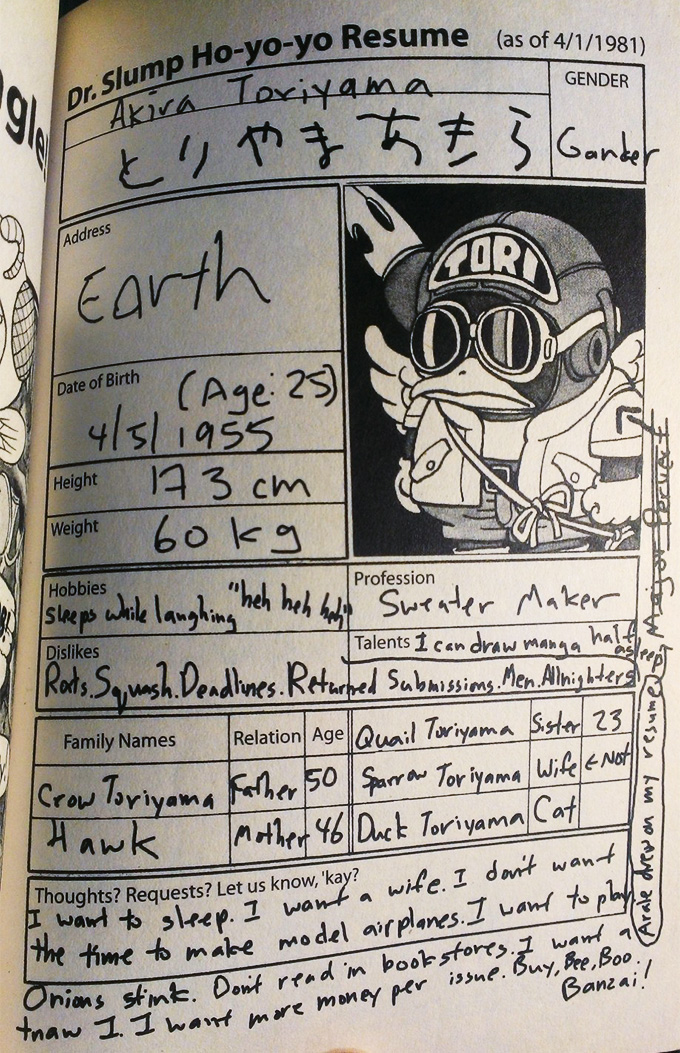
Continuing this variety, within the actual inline content of Volume 4 he uses his human rendering with the surgical mask, alongside his assistant at the time, Tanaka Hisashi.
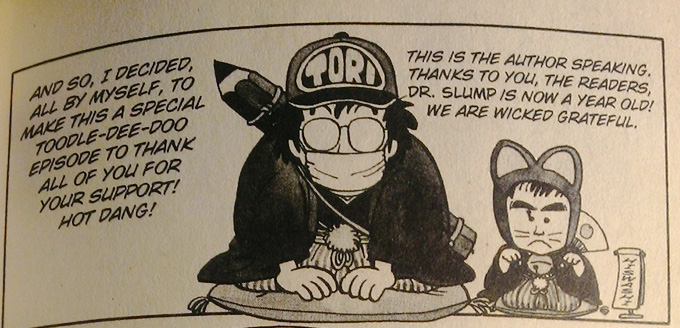
Finally, in Volume 5 (August 10, 1981), he actually names the robot.
Robotoriyama
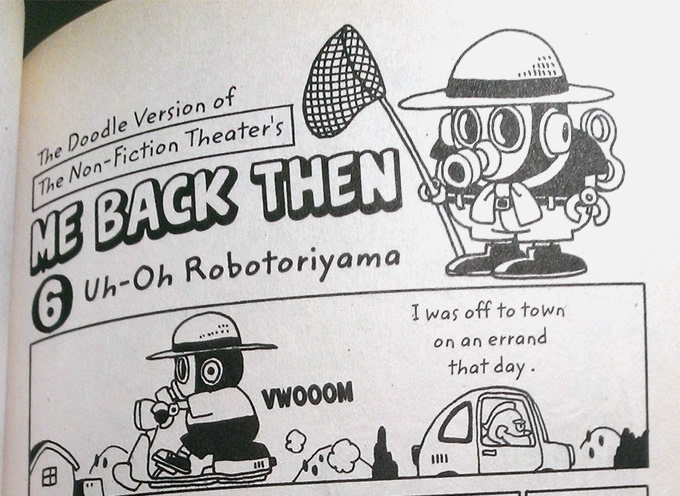
In a history section called “Me Back Then,” Akira Toriyama refers to his robot likeness as “Robotoriyama.”
Not “Tori-bot.”
This is what grabbed my attention and sparked the creation of this article.
I wondered if this was an English translation error, so I checked the original Japanese.
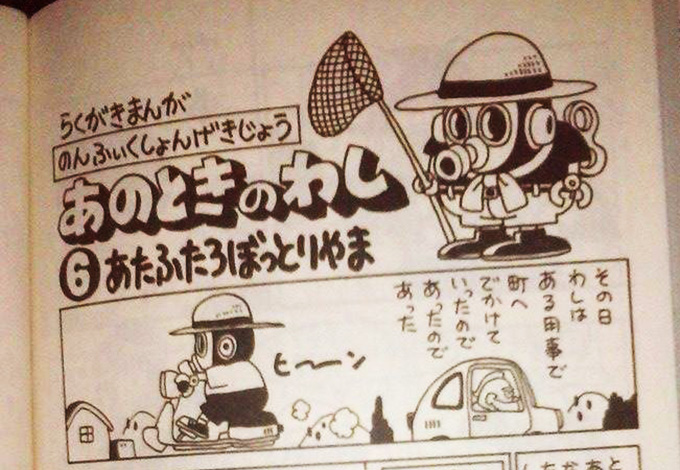
Sure enough, it’s written as Robotoriyama (ろぼとりやま).
Toriyama writes the name in hiragana, rather than in a combination of katakana for robo (ロボ), for it being a foreign term, and kanji for Toriyama (鳥山), as his name is usually written.
I feel like this choice of hiragana is similar to how he signs his signature, written in hiragana as “Toriyama Akira” (とりやまあきら).

We find confirmation of this Robotoriyama name in Dr. Slump Volume 8 (August 10, 1982) in a small sub-section within a trivia page in-between chapters, where readers voted on the “most useful inventions” in the manga.
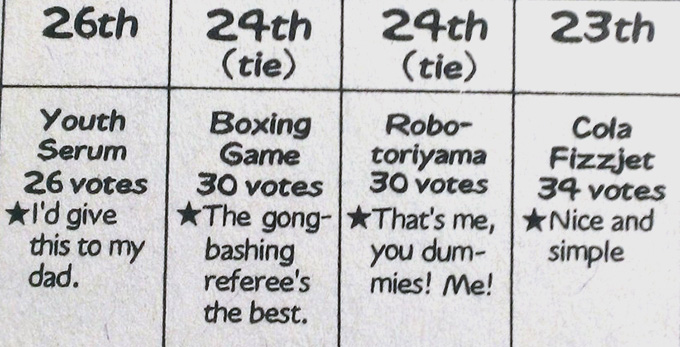
It seems 30 readers voted for Toriyama as a genius invention of Dr. Senbei (the titular “Dr. Slump”). In response he outright states that Robotoriyama and Akira Toriyama are the same person, and not an invention: “That’s me, you dummies! Me!”
The first time his likeness appears in serialized Weekly Shōnen Jump content is in Volume 5, as a small character on the title page of the chapter titled Monsters’ Night.
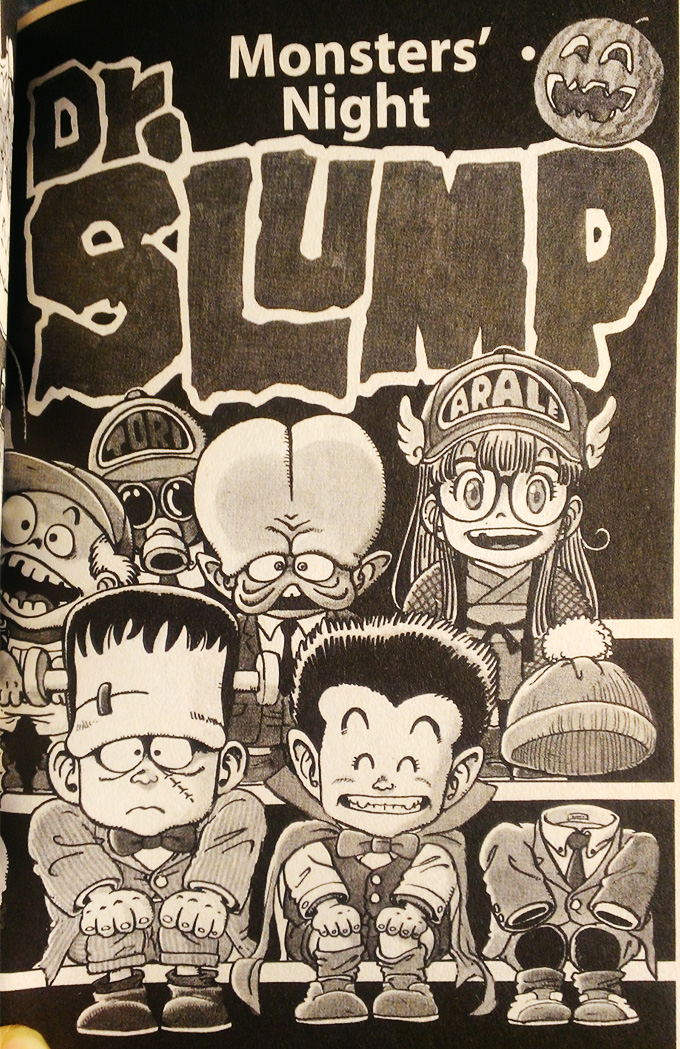
It isn’t until Volume 6 (December 10, 1981), in the Riders at Dawn chapter, where he uses the Robotoriyama character for inline content, as a member of the Fly Milk Gang.
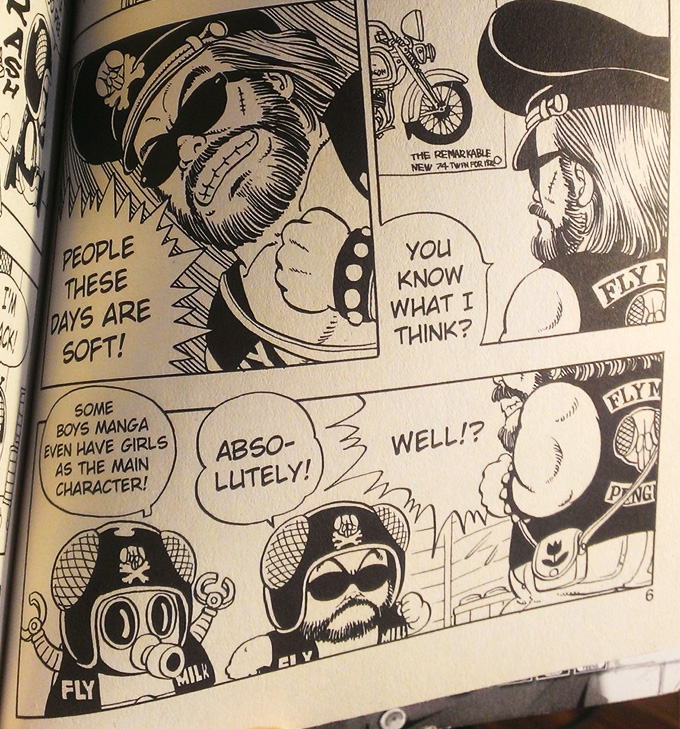
He is of course referring to Arale, the star of this shōnen manga. But given that this gang member is a derivative character, we can go one step further.
In Volume 6 he later (and finally) includes his complete likeness in inline content, as an advertisement for his own manga within his own manga.
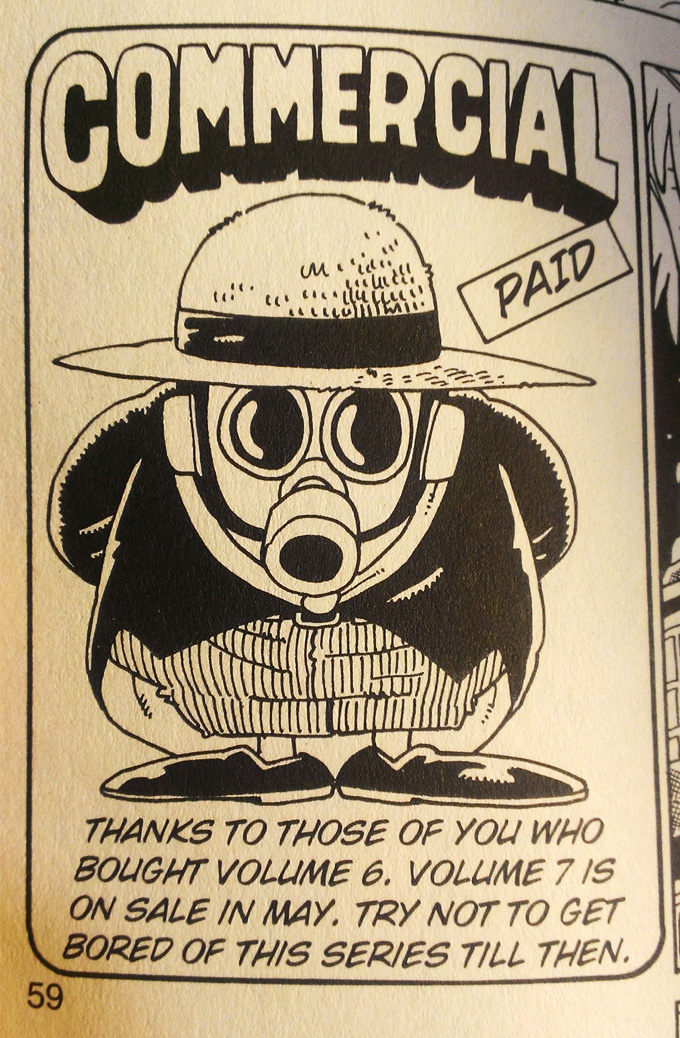
Following this he uses the Robotoriyama character in the Volume 6 chapter titled The Time Stoppers, where he, as the author, forces the Doctor to create a real-life time-stopping machine so that if he’s in a pinch he can activate it and gain more time to deliver the manga before his weekly deadline.
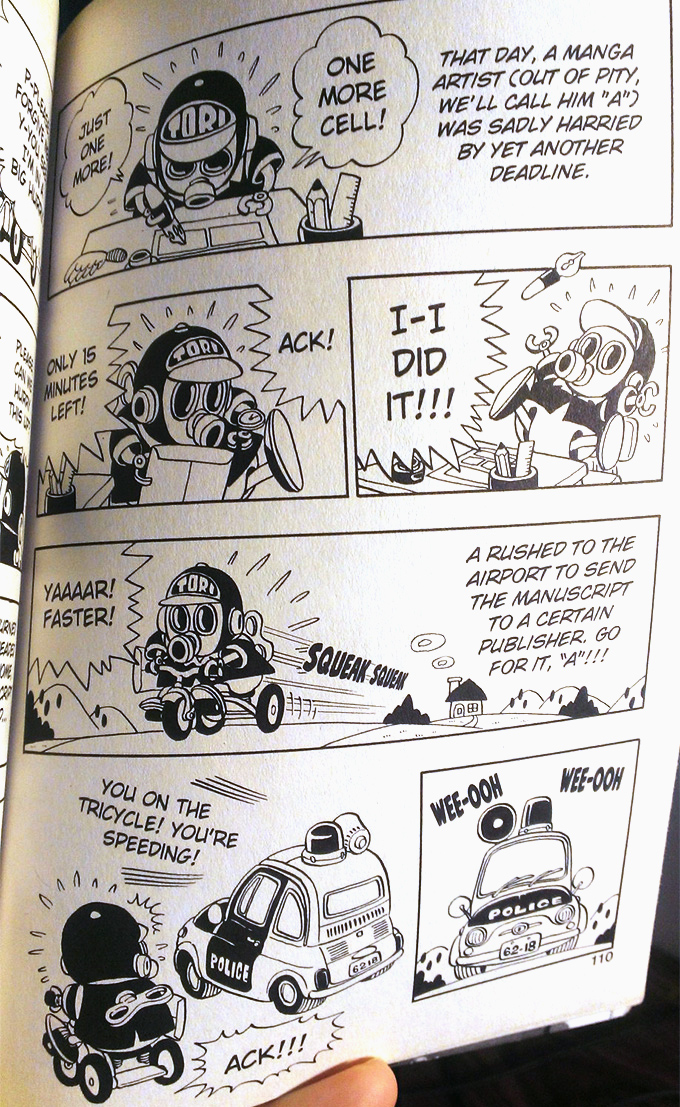
Robotoriyama goes onto become a recurring character in Dr. Slump, where he interacts with the main cast, apologizes for his laziness as an author, or gets himself into funny situations. As depicted here, he’s also seen frequently in Toriyama’s insert pages between chapters, where he recollects stories from his past.
So the character is well established in the pages of Dr. Slump over its 4 years of publication, and the author even calls himself Robotoriyama.
The big question then, is why do we call him “Tori-bot”?
Why Tori-bot?
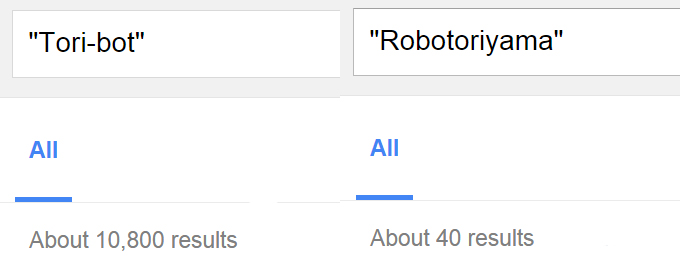
If you search for “Tori-bot” (in quotes) on Google you receive 10,800 results. If you search for “Robotoriyama” you only get 40 results, and most are junk.
In other words, almost nobody calls him by his real name, and we all use “Tori-bot.”
It turns out there are two factors at play for the reason why.
The first is a lack of awareness of this character in general, and his name in particular.
Japanese children in the 1980s grew up on Dr. Slump, and it’s Slump’s success that made Dragon Ball possible, so if you read Dragon Ball you likely already read Dr. Slump, or went back to read it.
Outside of Japan, Dragon Ball is much more popular than Dr. Slump. The fact is, most Dragon Ball fans have never read Dr. Slump. And those that have may not have noticed this single name on a single page in a single volume (although it does also appear in Volume 8 in that tiny sub-section).
In any case, it’s likely that 99% of fans have just never come across this name.
The second factor is that Dragon Ball fans had little reason to care.
The Robotoriyama character only appears 3 times in Dragon Ball. The first is in Chapter 3, where he’s climbing a palm tree—like many characters do in Dr. Slump—and saying “This is not Penguin Village,” the setting for Dr. Slump.
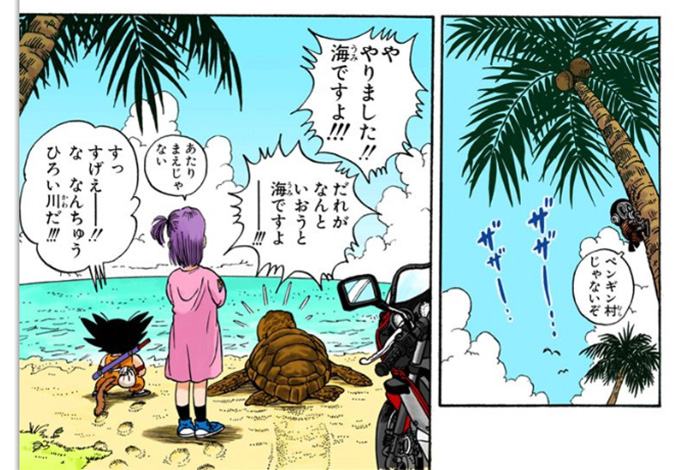
This is an in-joke for his readers just coming off of Dr. Slump and it makes no sense to international fans unfamiliar with his previous work.
The character then later appears in Chapters 433 and 480 as an audience member of the Tenkaichi Budokai’s. Again though, he’s there without explanation or context. So if you don’t know who this guy is, then by the time you’re done reading, you still have no clue.
Furthermore, in the official Daizenshū guidebooks his name for the Chapter 480 appearance is simply listed as “Toriyama Akira,” since that’s who he is.
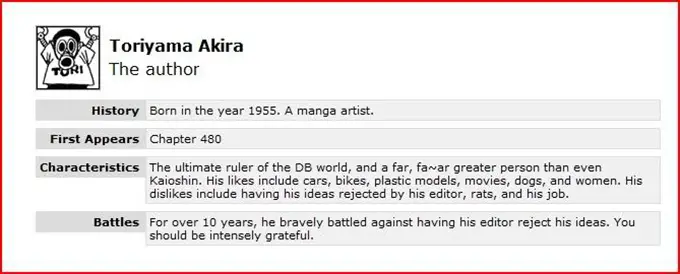
(image credit to kanzenshuu.com)
So if you just read Dragon Ball, you don’t pay much attention to this robot.
It’s actually through other forms of media that most Dragon Ball fans become familiar with him.
For example, the video game Tobal No. 1 was released in North America on September 30, 1996 for the Sony PlayStation. This is a street fighting game with characters designed by Akira Toriyama.
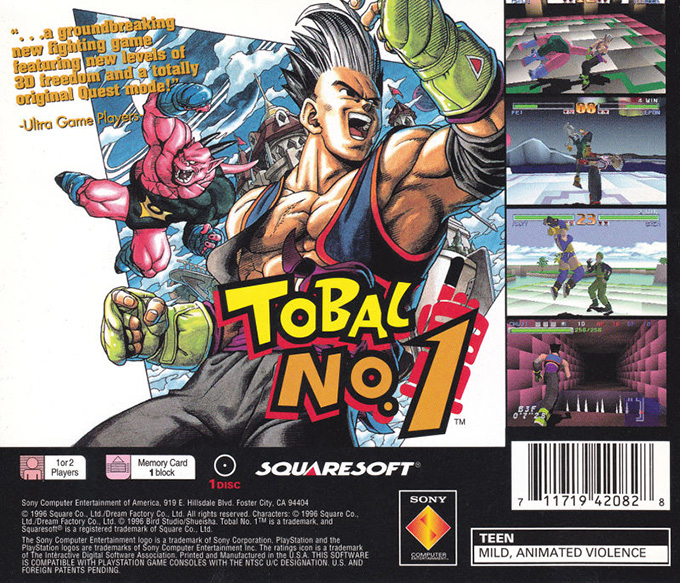
The final unlockable character in the game is Robotoriyama, who you unlock by completing the game’s Quest Mode.

As you can see, in the English version he’s simply named Tori. So perhaps this led to “Tori-bot,” since he’s a robot?
From what I can gather, in the Japanese original it’s written as “Toriyamarobo” (鳥山ロボ). This is a reversal of the name’s normal order and written with a mix of kanji and katakana.
According to this April 5, 1997 interview on IGN with Tobal No. 1 developer Square’s executive director, Hiromichi Tanaka, he says, “Yes. We call that character ‘Tori-Robo’ (Toriyama the Robot).” [1][2] This suggests that this English translation altered Tanaka’s words, because how can it be both ‘Tori-Robo’ and ‘Toriyama the Robot’? And why not Robotoriyama?
Merchandise could give us another clue, as there are countless pieces of Dragon Ball merchandise sold across the world. And each of them has a name on it.
However, unlike most Dragon Ball characters, Robotoriyama didn’t receive an action figure or statue until February, 2014, when this statue was finally released in Japan.

Problem is, its name is written entirely in katakana (トリヤマロボ) and is likewise reversed from the original name in the manga, saying “Toriyamarobo”!
So according to these official sources, Toriyama himself named it “Robotoriyama,” written in hiragana. Then the game creators named it “Toriyama-robo” in a mix of kanji and katakana. And finally the statue makers named it “Toriyamarobo” in full katakana. So confusing.
The point being that the vast majority of Dragon Ball fans never even take notice of this tiny robot in the series because he has little to no exposure or purpose. And then in these officially produced expressions of the character, none of them writes it as “Tori-bot.” Yet “Tori-bot” has been in use by English speaking fans, Spanish speaking fans, and so on, since at least as far back as I’ve been a fan, starting in 1997.
So if “Tori-bot” isn’t from the official sources, then where did it come from and why is it the defacto name outside of Japan?
I reached out to SaiyaJedi and Herms at Kanzenshuu.com for a possible origin story to “Tori-bot,” and they said they don’t know where it comes from but agreed that it is not the original name. SaiyaJedi said it may have come from Curtis Hoffmann.
Curtis Hoffmann
Curtis Hoffmann was a western Dragon Ball fan in the 1990s who started living in Tokyo in 1992 because of his love of anime.
Curtis became famous in the English-speaking Dragon Ball community for summarizing the content of Dragon Ball into English long before it was officially localized and made available. His summaries grew in popularity because Dragon Ball was still being published each week in Japan and his documents were the primary source that international fans used to discover the latest events in the series.
His summaries were hosted on his Dragon Ball Mirage website on GeoCities.[3][4] He published Volume 1 on Nov 7, 1993. For convenience, here is a direct download link to the zip file containing the .txt summaries.
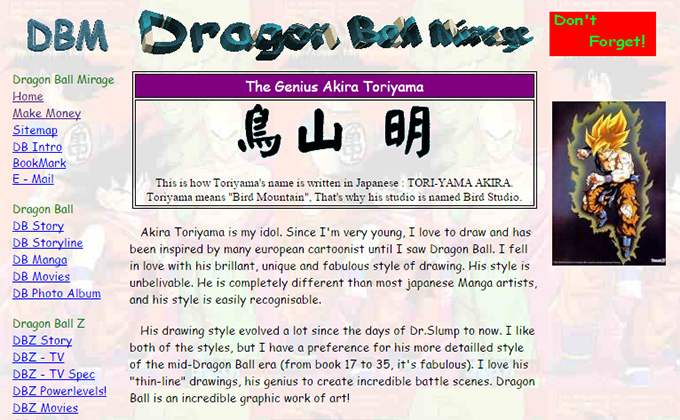
The summaries have some mistakes, but at the time of dial-up modems and a lack of information they were considered the gospel by Dragon Ball fans. As a result, their content spread around the Internet as more and more fans created their own DBZ fan pages on free websites like GeoCities and Angelfire. They also inspired many anime fans to become interested in Dragon Ball and served as their first exposure to the series.
Due to the lack of official translations, Curtis coined several phrases and terms. For example, Curtis is responsible for creating the term “Ultra Super Saiya-jin,” which refers to the more muscular “graded” or “ascended” forms of Super Saiyan between Super Saiyan 1 and Super Saiyan 2 that Vegeta, Trunks, and Goku display in the Cell Arc.
Ultra Super Saiya-jin isn’t an official term but it became such common parlance for these sub-forms that it found its way into different foreign translations, such as the German localization of the manga. It’s a term that’s still used throughout the global fandom, even though it’s not used in the original Japanese.
Curtis also coined the name “Kushami” for the name of Lunch’s alternate persona. Kushami is the Japanese word for “sneeze,” and Lunch transforms into that persona when she sneezes. But that’s not her actual name. In fact, it’s kyōbō-Ranchi (狂暴ランチ, “violent Ranchi,” “ferocious Ranchi,” or “fury Ranchi”).
Following this train of thought, SaiyaJedi suspects that “Tori-bot” may have been a name that Curtis coined to refer to Toriyama’s robotic likeness. The same result would then have occurred here, where fans took it as the actual name and then different localizers across the world used it as such. For example, the Spanish localizations use “Tori-bot” in their official releases.
To find out if this was true, I went through every archived page on his site and also went through his summaries, but there was no mention of Tori-bot by that name. Instead, on his website he calls it the “Toriyama robot” or “Toriyama’s robot-form.”
Nonetheless, being the stickler for details that I am, I tracked down Curtis’ contact info and sent him an email. Fortunately, he replied!
Origin of “Tori-bot”
Curtis says:
“I probably am the one that came up with that, or one of those that did.”
He then told me the story of how “Tori-bot” most likely came to be.
Curtis started living in Japan in 1992 and got a full-time job in Tokyo in ’93. There he met a man named Hitoshi Doi, who had been writing summaries of the Dragon Ball Z anime. Curtis started writing summaries of the manga, then took Hitoshi’s role of writing summaries for the anime in ’94 to ’95, and then continued writing summaries for Dr. Slump between ’95 and ’96. Then he returned home to Texas in ’96 and continued writing them until 99 when he changed jobs.
He says, “I started the DBZ character guide listings in ’94, and Slump in ’95, so the question of what to call Tori-bot would have arisen then on Mosaic. At that time, the internet still hadn’t taken off, and most online discussions of anime and manga were either through AOL or a university-based pre-internet text-only newsgroup system called Mosaic. I didn’t have a Mosaic account, so I’d meet with Hitoshi for lunch on Saturdays and give him my text files to upload for me, and he’d give me a floppy disk of the replies from the past week.”
“Later, in the U.S. I got cable internet and that’s when I started assembling the Akira Toriyama Super Database with the help of a lot of other fans internationally. Because the company allowed a couple gigs for webpages, I made the database in HTML, rather than the earlier text format, which then allowed for linking in gif and jpeg scans from the manga.”
“The thing to keep in mind for “Tori-bot” is that in the early days of Windows, Microsoft only supported 8-character filenames. Having 100 or so image files for the database, there were limits to what I could name a picture and still have it be understandable when it came time to link all the images into the HTML. Everything related to Dragon Ball would have started with “DB_” or “DBZ_”; while everything for Dr. Slump would have started with “DR_”. Pictures of Toriyama and his children would most likely have started with “Tori_”.
“Given that my text file of the Slump character guide makes mention of Toriyama in robot form and I didn’t use “Tori-bot” there, I’m pretty sure the name might have come from one of the page scan image files for the Super Database. I probably called the image “Tori_bot” because of the 8-character filename restriction.”[5]
He adds, “Most specifically with Dr. Slump, because Toriyama stopped writing himself into the Dragon Ball manga a few chapters after it started.”
So it’s not the Dragon Ball summaries that coined the name, nor the website’s text-based content, but rather, when Dragon Ball and Dr. Slump fans were looking for the name, info, or pictures of this robot character, they downloaded and then shared this image across the web. The file was called “Tori_bot,” so fans across the world were led to believe that Tori-bot is the character’s name.
As a result, it stuck! And now hundreds of millions of people across the global fanbase call this little guy Tori-bot… when that’s not his actual name.
Robo-Conclusion
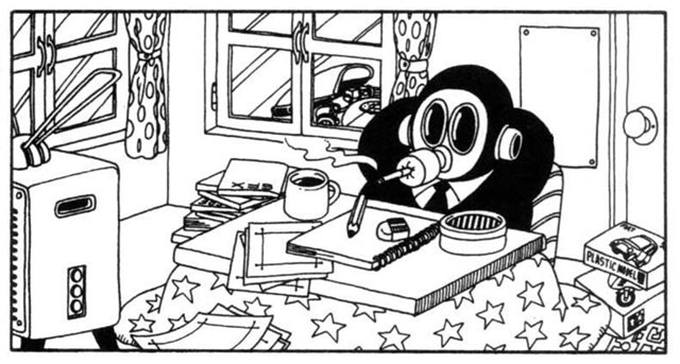
Phew! Now that I’ve finally solved this great mystery, I’m off to solve the world’s next biggest crisis! Should I end poverty, cure cancer, and bring world peace… Or research more Dragon Ball history?
Which version of his name do you prefer? Robotoriyama, Robo-Toriyama, Toriyama-Robo, or Tori-bot?
P.S. If you want to discover more of these detailed insights and revelations about your favorite series, pick up Dragon Ball Culture Volumes 1 and 2, available in print and ebook!
Footnotes
[1] Games Radar lists “Toriyama Robo” as one of the best unlockable characters in videogame history.
[2] Curtis Hoffman comments on the Japanese shortening of the full name to “Tori-Robo” by saying, “Back in the ’90s, no one would have used “Robotoriyama,” as it’s too long. The preference would have been for something shorter and more Japanese sounding—either “robo-tori,” “robo-akira,” “akira-boto,” or “tori-boto,” because the Japanese trend is to shorten names to the first couple syllables.”
[3] Curtis Hoffmann’s old GeoCities site is mirrored on OOCities.
[4] Curtis Hoffmann’s website is at http://tsoj.manga.org, which is where you can find his Akira Toriyama Super Database archive. You can also read Curtis’s posts on the archived Google Groups pages.
[5] Curtis adds a caveat, “I don’t have proof that I coined “tori-bot,” as a lot of the files I’d created back then were lost in server crashes. But I was one of the first to try to organize all that for the guides, and no one then would have used “robotoriyama” because of the Japanese trend to shorten names to the first couple syllables.”
' . $comment->comment_content . '
'; } } else { echo 'No comments found.'; }